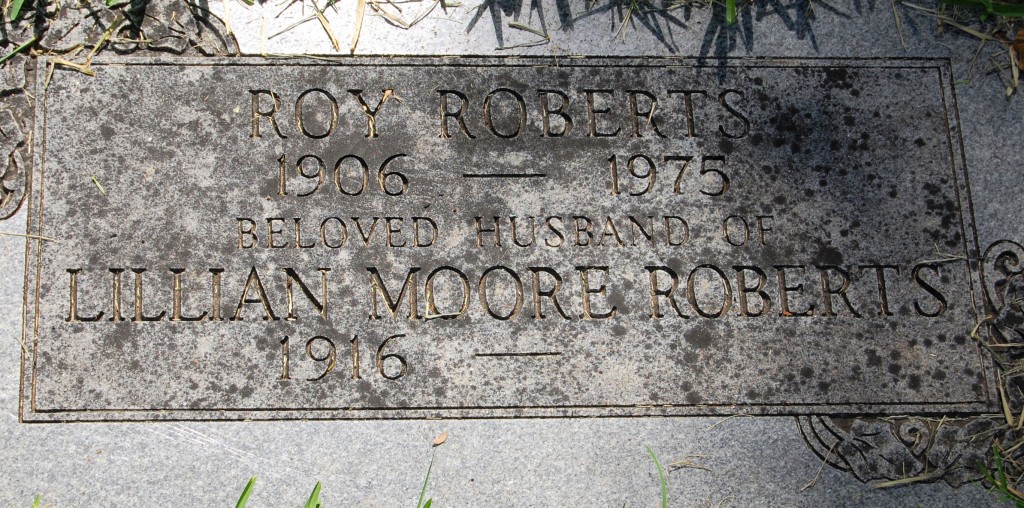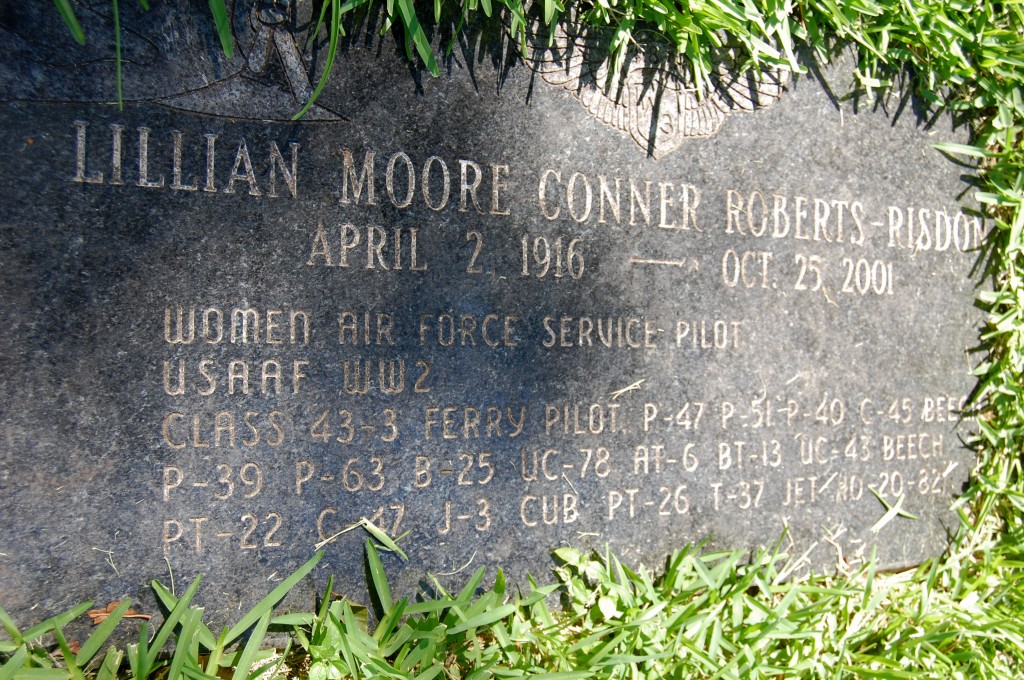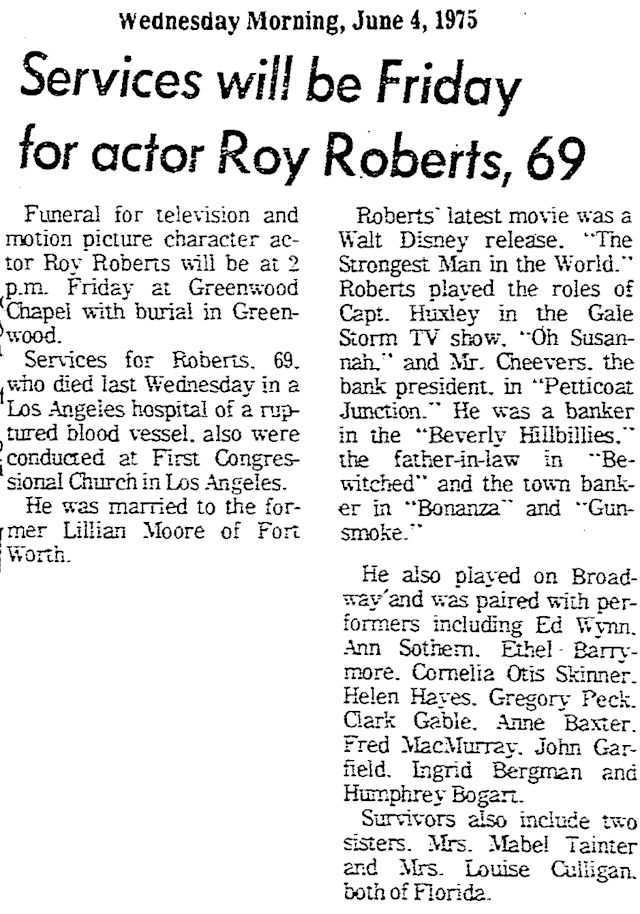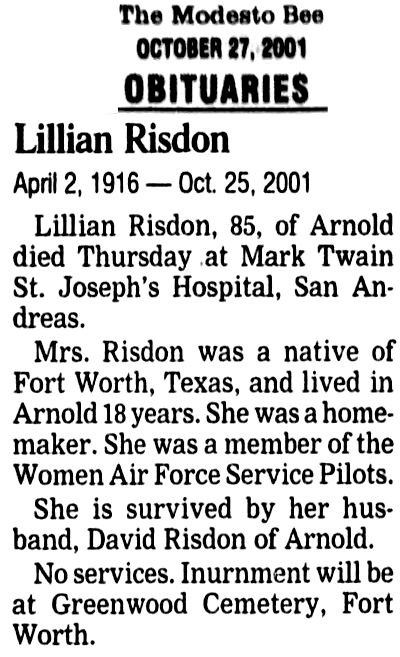You’d recognize his face in an instant but might walk right past his simple, flat tombstone:

On the other hand, you wouldn’t recognize her face but certainly might pause at her tombstone, with its résumé that hints at a life that was at least as interesting as his was:

Husband and wife Roy Roberts and Lillian Moore Roberts are buried side by side at Greenwood Cemetery. He was born on March 19, 1906 in Florida and died on May 28, 1975. She was born in Fort Worth on April 2, 1916 and died on October 25, 2001.
This husband and wife constituted a most unusual power couple.
Roberts acted on the Broadway stage, then moved to Hollywood, where he became one of the most ubiquitous character actors in movies and TV during the 1940s-1970s: westerns and films noir in the 1940s, Oh, Susanna (Gale Storm Show) in the 1950s, dozens of westerns, dramas, and comedies on TV in the 1960s, Chinatown in the 1970s. He claimed to have been in more than nine hundred films and TV shows during a forty-year career.
For example:

From top to bottom, left to right: Bewitched, Chain Lightning, Force of Evil (with Paul Fix, future sheriff of Rifleman), Andy Griffith Show, The Enforcer (with Humphrey Bogart), He Walked by Night (with Jack Webb), House of Wax, Perry Mason, Petticoat Junction, Chinatown.
 Roy Roberts died in Los Angeles in 1975. His obituary mentions his wife but gives no details beyond her tie to Fort Worth.
Roy Roberts died in Los Angeles in 1975. His obituary mentions his wife but gives no details beyond her tie to Fort Worth.
 Lillian Moore Roberts was, in fact, born in Fort Worth. As a child she was an avid equestrian. After her family moved to California, she had a short career as a film actress in the early 1930s, mostly in uncredited roles but including an appearance in an Our Gang short. But when World War II came, Moore found the role she was meant to play. She wanted to serve in the war effort. So, in 1941 she moved to Miami and earned a pilot’s license. She then became assistant to Jacqueline Cochran, a pioneer American aviator and organizer of the wartime Women’s Auxiliary Army Corps (WAAC) and Women Airforce Service Pilots (WASP). Lillian Moore Roberts served as Cochran’s assistant until 1943, when Roberts herself joined the WASP, becoming one of the first women to fly for the military. The women flew as civilian pilots in an Army Air Corps experimental program to determine if women could serve as ferry pilots and relieve men for overseas duty. Twenty-five thousand women applied to join the WASP, but only 1,074 passed the training, which was the same training required of male Army Air Corps pilots. Part of the duty of ferry pilots was to fly planes to embarkation points such as Long Beach, California, and Newark, New Jersey. Between 1942 and 1944 thirty-eight WASP pilots were killed in service.
Lillian Moore Roberts was, in fact, born in Fort Worth. As a child she was an avid equestrian. After her family moved to California, she had a short career as a film actress in the early 1930s, mostly in uncredited roles but including an appearance in an Our Gang short. But when World War II came, Moore found the role she was meant to play. She wanted to serve in the war effort. So, in 1941 she moved to Miami and earned a pilot’s license. She then became assistant to Jacqueline Cochran, a pioneer American aviator and organizer of the wartime Women’s Auxiliary Army Corps (WAAC) and Women Airforce Service Pilots (WASP). Lillian Moore Roberts served as Cochran’s assistant until 1943, when Roberts herself joined the WASP, becoming one of the first women to fly for the military. The women flew as civilian pilots in an Army Air Corps experimental program to determine if women could serve as ferry pilots and relieve men for overseas duty. Twenty-five thousand women applied to join the WASP, but only 1,074 passed the training, which was the same training required of male Army Air Corps pilots. Part of the duty of ferry pilots was to fly planes to embarkation points such as Long Beach, California, and Newark, New Jersey. Between 1942 and 1944 thirty-eight WASP pilots were killed in service.
Lillian Moore Roberts trained at Houston’s Howard Hughes Field and at Sweetwater’s Avenger Field, then was stationed at Romulus Army Air Base in Michigan until WASP disbanded in 1944.
Her tombstone lists the aircraft she flew, including B-25, P-51, T-37 jet trainer, and C-47.
Roy and Lillian married in 1945. He was just starting his long acting career. She continued to fly and from 1978 to 1980 was president of the WASP alumni organization.
 Lillian died in 2001 in Arnold, California, where she had lived eighteen years. Her hometown newspaper described her as a “homemaker” and devoted one sentence to her wartime work. It did not mention Roy Roberts.
Lillian died in 2001 in Arnold, California, where she had lived eighteen years. Her hometown newspaper described her as a “homemaker” and devoted one sentence to her wartime work. It did not mention Roy Roberts.
In 2009 Lillian Moore Roberts and other WASP pilots were awarded the Congressional Gold Medal for their wartime service.
Posts About Aviation and War in Fort Worth History
Posts About Women in Fort Worth History





